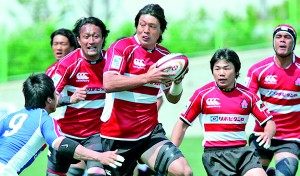Going professional is the only way out
View(s):Japan head coach Eddie Jones is outspoken and does not hold back his punches as he gets his point across. So it came as no surprise when he called on his employers, the Japan Rugby Football Union, to do more to help raise the standards of the game across Asia.
Japan is the perennial powerhouse rugby nation in the region. Ever since they were invited to take part at the first Rugby World Cup in 1987 by the International Rugby Board, they have represented Asia by qualifying on every other occasion.
There is little doubt that next year too Japan will fly the flag for the region. The 2014 Asian Five Nations Top Five competition will decide the automatic berth given to Asia, and Japan who were crowned champions for the sixth consecutive year last weekend, will be outright favourites once again.
Why does Japan dominate so easily? No prizes for the right answer which is simply that they are the only Asian country to possess a professional league.
The Japan Top league comprises 14 teams, mostly backed by large corporations like Sony and Mitsubishi. Launched in 2003, it has been credited with raising standards in Japan – ranked 15th in the world – largely due to the introduction of full-time professional mainly from Australia and New Zealand.

Japan is the perennial powerhouse rugby nation in the Asian region
Everyone from All Black Dan Carter to Wallaby George Smith has plied their trade in the lucrative league. The money is big and is a huge incentive, especially for players who are reaching the tail end of their careers and want to save something for a rainy day.
Their presence has raised the level of the game massively. It has forced the local Japanese youngster, fresh from university, to open his eyes to the demands of modern-day professional rugby players. He has to be fitter, faster and stronger.
The last attribute is paramount in today’s game where winning the breakdown can mean the difference between winning and losing. Upper body strength and strong thighs enables a player to keep his feet and contest for the ball.
Jones revealed that one of his main demands to players is that they bulk up. Japan No.8 Takashi Kikutani has gone from 98 kilograms to 104 kgs. Captain and winger Toshiaki Hirose jumped from 79 to 84 kilos. Talented fullback Ayumu Goramaru has bulked up and is looking the way Scotland’s Gavin Hastings did in his prime.
Power and strength has turned Japan’s pack into 875 kilograms of tough meat on the hoof. Sri Lanka’s forwards weighed in at a creditable 837 kilograms during last month’s Division One competition which they won easily beating Kazakhstan, Chinese-Taipei and Thailand. But the bar will now be raised next season in the Top Five. And what is the best way to be competitive?
Back to Jones who said if teams are to be able to match Japan they should be playing regular rugby at a higher level. That is they have got to move out of the comfort zone they are in presently.
Jones told Hong Kong that the only way to close the gap on the Brave Blossoms was if the Hong Kong Rugby Football Union fielded a franchise in the Japan Top League. He called the JRFU to help out.
“Just imagine having teams from Hong Kong and South Korea in this competition, or even playing in a regional club championship like soccer’s AFC Champions League,” said Jones. “This would generate a lot of interest and help raise the standards of the game.”
Three years ago, a similar idea was mooted by Jones’ predecessor, John Kirwan, and it was supported then by the HKRFU’s national coach Dai Rees.
Rees said at the time: “I don’t think we are ever going to close the gap on Japan until we seriously handle the performance end. And the only way to do this is to look at the prospects of having a Hong Kong franchise in their professional league.”Hong Kong and Korea are well-placed to do so, financially and geographically. There are big multi-national corporations who are headquartered in Hong Kong. Just imagine if HSBC got into the act. In Korea the corporates are as big, if not bigger than in Japan. What if Samsung or Hyundai felt that a Seoul-based rugby franchise was the way to go?
There is a long way to go before such a dream can be achieved. But until then, the Korean Rugby Football Union has decided to act by acquiring individual players spots in Japan Top League. Presently there are 11 Koreans playing in Japan, seven of them forwards.
The Philippines have around six players too – they are of Filipino heritage, Australian dads and Filipino mums – in Japan. Hong Kong had a couple, winger and sevens captain Rowan Varty and flanker Mark Wright.
It has dawned on everyone that playing at a higher level than what you are used to will haul your game up. Japan, meanwhile, is going outside its own comfort zone. This season, they had three players contracted to play Super Rugby.
Sri Lanka can only raise its own standards by mixing with the best. One way is getting more foreign players involved in the local domestic competition, as is being done now. The other is for the Union to try and embed selected players in foreign leagues. If I remember correct, one of Sri Lanka’s best ever No.8s Priyantha Ekanayake had a stint playing overseas. The road has been travelled and must continue to be travelled more frequently.
Follow @timesonlinelk
comments powered by Disqus


